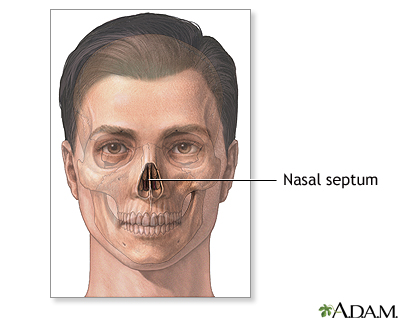Septoplasty
Nasal septum repair
Septoplasty is surgery performed to correct any problems in the nasal septum, the structure inside the nose that separates the nose into two chambers.

The septum is the cartilage and bony partition that separates the two nasal chambers (nostrils).
Description
Most people receive general anesthesia for septoplasty. You will be asleep and pain-free. Some people have the surgery under local anesthesia, which numbs the area to block pain. You will stay awake if you have local anesthesia. Surgery takes about 1 to 1½ hours. Most people go home the same day.
To do the procedure:
The surgeon makes a cut inside the wall on one side of your nose.
- The mucous membrane that covers the wall is elevated.
- Cartilage or bone that is causing the blockage in the area is moved, repositioned or taken out.
- The mucous membrane is put back in place. The membrane will be held in place by stitches, splints, or packing material.
Why the Procedure Is Performed
The main reasons for this surgery are:
- To repair a crooked, bent, or deformed nasal septum that blocks the airway in the nose. People with this condition very often breathe through their mouth and may be more likely to get nasal or sinus infections.
- To treat nosebleeds that cannot be controlled.
- To help alleviate snoring resulting from a nasal blockage.
Risks
Risks for any surgery are:
- Allergic reactions to medicines
- Breathing problems
- Heart problems
- Bleeding
- Infection
Risks for this surgery are:
- Return of the nasal blockage. This could require another surgery.
- Scarring.
- A perforation, or hole, in the septum.
- Changes in skin sensation.
- Unevenness in the appearance of the nose.
- Skin discoloration.
Before the Procedure
Before the procedure:
- You will meet with the doctor who will give you anesthesia during the surgery.
- You go over your medical history to help the doctor decide the best type of anesthesia.
- Be sure you tell your health care provider about any medicines you take, even drugs, supplements, or herbs you bought without a prescription. Also tell your doctor if you have any allergies or if you have a history of bleeding problems.
- You may need to stop taking any drugs that make it hard for your blood to clot 2 weeks before your surgery, including aspirin, ibuprofen (Advil, Motrin), naproxen (Aleve, Naprosyn), and some herbal supplements.
- You may be asked to stop eating and drinking after midnight the night before the procedure.
After the Procedure
After the procedure:
- You will most likely go home on the same day as surgery.
- After surgery, both sides of your nose may be packed (stuffed with cotton or spongy materials). This helps prevent nosebleeds.
- Most of the time, this packing is removed 24 to 36 hours after surgery.
- You may have swelling or drainage for a few days after the surgery.
- You will likely have small amounts of bleeding for 24 to 48 hours after surgery.
Outlook (Prognosis)
Most septoplasty procedures are able to straighten the septum. Breathing usually improves.
References
Beswick DM, Ramakrishnan VR. Septoplasty and turbinate surgery. In: Scholes MA, Ramakrishnan VR, eds. ENT Secrets. 5th ed. Philadelphia, PA: Elsevier; 2023:chap 28.
Gillman GS, Lee SE. Septoplasty - classic and endoscopic. In: Meyers EN, Snyderman CH, eds. Operative Otolaryngology: Head and Neck Surgery. 3rd ed. Philadelphia, PA: Elsevier; 2018:chap 95.
Kridel RWH, Sturm A. The nasal septum. In: Flint PW, Francis HW, Haughey BH, et al, eds. Cummings Otolaryngology: Head and Neck Surgery. 7th ed. Philadelphia, PA: Elsevier; 2021:chap 29.
Version Info
Last reviewed on: 3/1/2023
Reviewed by: Josef Shargorodsky, MD, MPH, Johns Hopkins University School of Medicine, Baltimore, MD. Also reviewed by David C. Dugdale, MD, Medical Director, Brenda Conaway, Editorial Director, and the A.D.A.M. Editorial team.
